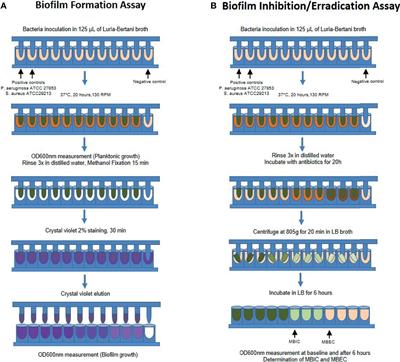biofilm assay protocol
In many assays biofilms are quantified by conventional culture plating method to get colony 10 forming unitscount which is an intensive procedure 1 Whereas other assays do use 96 well 11 microtiter plates for biofilm quantification as microtitre plate offers comparatively high 12. In summary the protocol optimized by ImQuest BioSciences provides a high throughput procedure to screen drug candidates for activity against P.
01 crystal violet solution in water see Notes 3 5.
. By STEP 2 the value that represents the turbidity of each well after the broth removal was obtained. Shake the 96-well plate over the tray again and rinse out the crystal violet in a large beaker of water. A Biofilms form on the pegs of the MBEC Assay when planktonic bacteria adhere to the surface.
The protocols can be implemented in most microbiology or immunology research laboratories without the need for specialists. Dispersed cells are also shed from the surface of. National Center for Biotechnology Information.
96-well microtiter plate not tissue culture treated see Note 1. Stain all wells used in the assay with 125 μL of 01 crystal violet for 10 minutes. The MBEC assay uses a Calgary Biofilm Device CBD a 96-well plate with pegs built into the lid that allow for the adherence and growth of biofilm.
This simple design is very popular due to its high-throughput screening capacities low cost and easy handling. A step-by-step summary of the MBEC Assay. The biofilm processing was done as described above.
4- keep without no agitation for 24 or 48 or 72 days until. 4 The peg lid is gently rinsed to removed planktonic bacteria and a serial diluted test solution is dispensed into a new 96-well microplate. The assays were performed in microtitre plates with two minimal and two enriched broths with one- or two-steps protocol and using three different mathematical.
The MBEC minimum biofilm eradication concentration Assay can be used to determine the efficacy of an antimicrobial agent against biofilm. Biofilm formation in microtiter plates is certainly the most commonly used method to grow and study biofilm. Four flat containers of sufficient size to hold 96-well plate submerged in liquid see Note 2.
Aeruginosa biofilm was cultivated on 18 beads according to the standard protocol and processed as described above to determine the number of CFU per bead. Publication types Research Support Non-US. The MTT assay has high-throughput potential and can be efficiently used for determination of biofilm-forming capacity of microorganisms from individual machines in metalworking industry.
In this study we have evaluated the impact of methodological approaches in the determination of biofilm formation by four clinical isolates of Escherichia coli in static assays. Kwasny SM and Opperman TJ. In STEP 1 the absorbance value of the bacteria planktonic growth after the incubation was obtained.
Inoculate 5ml liquid medium with 5µl 1st Overnight culture use disposable test tubes and incubate at proper conditions overnight. Biofilm Assay Protocol for Biofilm assay by Safranin using 96-well plates. It could be considered as the value representing the development of each microorganism in an aqueous medium before any manipulation.
In the protocol described here we focus on the use of 96-well optically clear polystyrene flat-bottom plate to study. Iofilms are encased in slime which is sometimes visible to the naked eye. In the presence of shear forces these bacteria become attached and form mature biofilms.
One of the first staining assays used in biofilm analysis was the crystal violet assay. Pipetter and 200 μL tips see Note 6. 1-2 Bacteria culture is prepared and dispensed into a 96-well microplate.
In addition some assays can. Cover the bench top with more paper towels and hit the plate against the bench top until all wells are free of liquid crystal violet. 21 Biofilm Assay 1.
Aeruginosa biofilms and is especially suitable to rapidly identify highly active inhibitors of biofilm formation. In addition as part of. The quantitative assay methods for anti-biofilm activity based in colorimetric methodologies are similar to the microbroth dilution assay described in the Clinical Laboratory and Standards Institute CLSI document M7-A7.
1- grow the bacteria 2- guarantee the pure culture 3- next form the biofime add 500 microliters of bacteria into a 24 well microplate. Scanning Electron Microscopy SEM. In this method the negatively charged molecules within a biofilm.
3 The peg lid is placed in the bacteria culture and incubated to generate the biofilm. MBEC assay is a very time efficient and accurate. The use of the assay may also guide the selection of the most appropriate biocide to fight these microorganisms.
Apply the second overnight culture into plates as your experimental designed pattern and perform the experiment as follow. This experiment was then repeated twice to achieve a total of three runs.

An Improved Crystal Violet Assay For Biofilm Quantification In 96 Well Microtitre Plate Biorxiv

Assess The Cell Viability Of Staphylococcus Aureus Biofilms Thermo Fisher Scientific De

Biofilm Eradication Testing For Antimicrobial Efficacy

Schematic Representation Of The Steps Involved In The Protocol For Download Scientific Diagram

Biofilm Formation Assay Kit Testpiece Dojindo Eu

Biofilm Formation Assay Kit Dojindo

Biofilm Eradication Testing For Antimicrobial Efficacy

Biofilm Formation Assay In Pseudomonas Syringae Bio Protocol

Biofilm Formation Assay Kit Dojindo

Biofilm Formation Assay In Pseudomonas Syringae Bio Protocol

Schematic Crystal Violet Assay On Biofilms In A Microtiter Plate Download Scientific Diagram

An Overview Of The High Throughput Protocol For Metal Susceptibility Download Scientific Diagram

An Improved Crystal Violet Assay For Biofilm Quantification In 96 Well Microtitre Plate Biorxiv

An Overview Of The High Throughput Protocol For Metal Susceptibility Download Scientific Diagram

Polystyrene Microtiter Plate Biofilm Assay Of A Pleuropneumoniae Download Scientific Diagram

Biofilm Formation Assay Kit Dojindo

Microtiter Dish Biofilm Formation Assay Protocol

Frontiers Biofilm And Planktonic Antibiotic Resistance In Patients With Acute Exacerbation Of Chronic Rhinosinusitis

Comments
Post a Comment